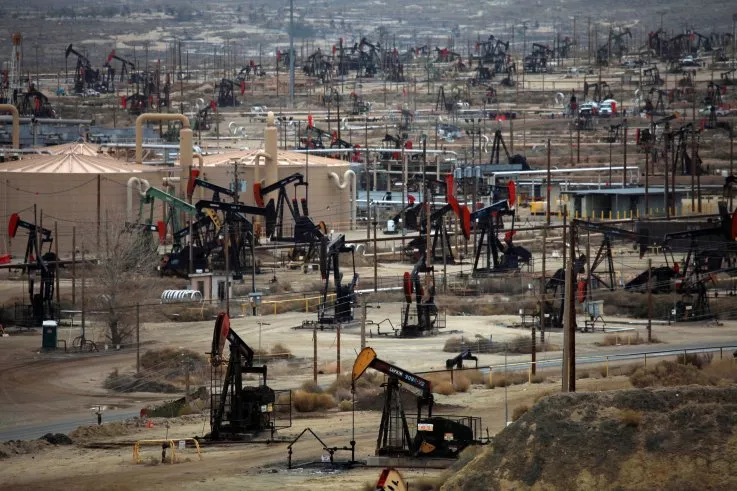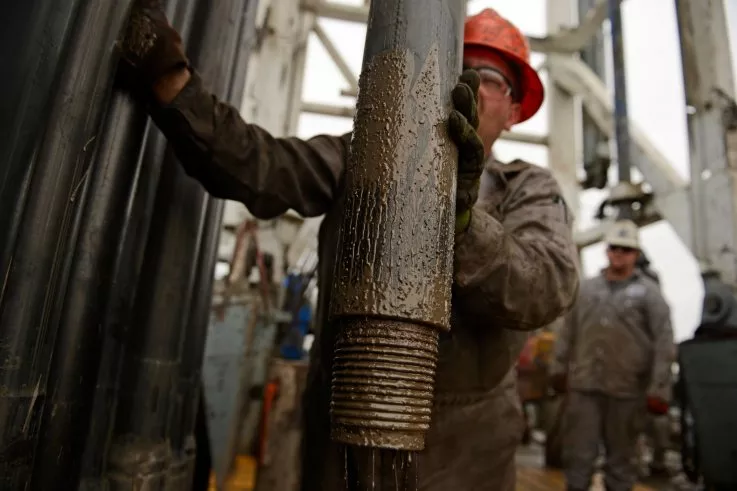You Know the Drill
Newsweek
October 11, 2013
Flying northwest of Aspen in a small aircraft – a single-engine Cessna Centurion 210 – I discreetly vomit into a bag of candy I find in the side door of the cockpit. The pilot, Bruce Gordon, glances back and nods with approval.
“You vomit beautifully,” he says.
“Thank you.”
We are cruising the Roan (pronounced ROE-AHN) Plateau at 180 miles an hour from an altitude of 10,000 feet. It is a wildlife refuge in Colorado teeming with animals. But it is also federal land that is hotly contested by oil and gas drillers. Etched across the mountainous terrain are hundreds of winding paths leading to drill sites.
Dotting the high ridges and forests are outbuildings and drill rigs – camouflaged in accordance with a handbook stipulating colors acceptable to federal regulators – as well as dingy wastewater pools left over from the drilling process, which cannot be concealed.
The drilling areas are easy to spot. “In the past few years, it has totally taken over the landscape,” says Gordon, executive director of EcoFlight, a nonprofit that sponsors flights over drill sites, forest clear-cuts and strip mines to educate those who don’t get to regularly see the full impact on the land of the energy-extraction process. “The pristine areas are so few now, they really catch your eye,” he said. “You can’t fly 30 minutes in any direction without seeing the wreckage.”
That was 2011, just as America came off its first full year of extracting more than 35 percent of its crude oil and nearly 25 percent of its natural gas from lands and territories owned by the U.S. taxpayer, transforming itself into a net exporter of petroleum products for the first time since 1949. The Roan Plateau figured prominently in that turnaround, reaping the greatest amount ever paid in the lower 48 states to the U.S. Treasury by drillers looking to strike it rich on federal land. Yet the total paid for ground leases came to just over $100 million, a drop in the bucket compared with the revenue oil and gas companies reported in the whole of Colorado that year – well over $9 billion.
And therein lies the rub. America owns an enormous swath of the land at the heart of the nation’s energy boom – stunning wildlife territories like the Roan Plateau, where oil and gas can be found alongside rare plant and animal habitats – but American taxpayers are not very much benefitting financially.
The problem traces back to America’s early days, when the concept of manifest destiny spurred President Ulysses S. Grant in 1872 to sign a mining law that allowed wildcatters stabbing westward to exploit resources on federal land at little to no cost – and keep most of what they found without having to share any of it.
“Obviously, back then they weren’t even dreaming of drilling for oil or gas, but the post-Civil War era of encouraging Western settlement by giving away natural resources is still reflected in U.S. policy today,” says Roger Flynn, who teaches mining and natural resources law at the University of Colorado at Boulder and is director of the Western Mining Action Project, offering legal advice to conservation groups and Native American tribes.
In 1920, Congress rejiggered its rules on the heels of the oil rush at the turn of the century, insisting drillers pay a low annual lease rate, revised periodically, for the right to drill on taxpayer-owned lands and requiring them to contribute one eighth of their sales revenue in royalty. Nearly 100 years later, that policy remains the law of the land, robbing Americans of untold billions, even as they’re forced to pay record-high prices at the pump.
That is no rash accusation from a tree hugger or a Luddite. It is the verdict of the U.S. Government Accountability Office, a nonpartisan research arm of Congress, after extensive research. Despite the promise that energy independence would benefit everyone, it is looking less likely Americans will be able to afford to enjoy their own energy heyday.

JIM WILSON
Oil wells in the Midway-Sunset oil field in Fellows, Calif. Jim Wilson/The New York Times
Why is America lowballing itself?
“There is a lot of blame to go around when it comes to how much the American taxpayer is getting for all this drilling,” says Peter Kolbenschlag, an energy consultant with Mountain West Strategies in Paonia, Colo. “What we’re seeing right now is the result of a lot of special interests influencing fiscal policy in Washington.”
Americans may be surprised to learn that although leases on taxpayer-owned territories can fetch thousands of dollars an acre in the competitive bidding process, the starting bid for an annual lease to explore for 10 years is just $2 an acre. (That is not a typo.) Put it this way: America charges less for drilling on an acre of taxpayer-owned land for a decade than Starbucks charges for a cup of coffee. According to the Bureau of Land Management, the arm of the U.S. Department of the Interior that manages land leases, there are no plans to change that.
If you factor in inflation, the spending power of $2 in 1987 is the equivalent of 50 cents today, according to the U.S. Bureau of Labor Statistics. So, even as energy prices skyrocket, the nation is charging Big Oil a quarter of what it did 30 years ago.
“The main question is, what does the Interior [Department] think is the right amount for us to be paid on our nation’s resources now? And are we there yet?” says Frank Rusco, director of natural resources and the environment for the GAO, which just completed an analysis of energy drilling and the Interior Department’s handling of its valuations that is due to be published next month.
Sinking a well means paying royalties – another sticking point between Big Oil and America. Onshore, oil and gas majors pay a royalty rate of 12.5 percent, based on sales of what they drill and produce. Offshore, that is slightly higher, 18.75 percent, hiked in 2007 from the 12.5 percent rate set in the 1920s. (The higher, offshore rate reflects only leases granted since 2007, which means most of the money paid to Uncle Sam comes under the older, lower rate.) Onshore rates have yet to be revised upward and proposals to boost royalties when oil prices meet high price thresholds have been met with heated opposition from members of Congress at the encouragement of Big Oil.
But in the past, Interior, which has discretionary powers over how royalties are collected, hasn’t done itself any favors, either. Authorized by Congress to set rates based on fair market value, in 1982 the department decided that charging “fair market value” should not be defined by the value of the oil and gas discovered and produced on U.S. onshore and offshore territories, but on the value of the “right to explore.”
Efforts to increase the return to taxpayers weren’t helped when in 2009 the Interior Department appealed to the Supreme Court to collect royalties from oil and gas companies worth billions of dollars. The Supreme Court refused to hear the case. “Whatever the precise amount of foregone future royalties ultimately proves to be, the total cost will be huge, and it will have a direct, adverse effect on the Treasury of the United States,” the petition stated. At the time, the amount lost was estimated to be $19 billion.

CHRISTOPHER LAMARCA/REDUX
The environmental impact of natural gas drilling in Pinedale, Wyoming. Christopher LaMarca/Redux
The main issue with overhauling how the U.S. charges oil and gas companies can be summed up fairly easily, says Alan Jeffers, spokesman for ExxonMobil. “Our expectation is that when certain rules are put in place, they don’t change across the life of the investment, including changing the royalty structure. That is standard across the natural resources industry. We live up to our end of the bargain and we expect others to do the same.” In short, the U.S. made a bad deal.
In privately negotiated land deals, many property owners have questioned whether royalty rates are fair, stating that oil and gas companies often deduct various hidden costs and pay a net royalty instead of a gross one. “That’s what I call the Enron-accounting royalty rate, because after deducting all kinds of unknown costs, there’s your royalty,” says Flynn. “If I was advising someone who was looking to negotiate a private land deal as their attorney, I would never allow them to accept a net royalty.”
How do government rates compare with privately negotiated U.S. leases and royalties? While deal data vary from state to state and are generally confidential, most participants, as a rule, size up the government lease and royalty rates as the rock-bottom minimum. The federal royalty rates are set by the Secretary of the Interior and stay fixed, even as energy prices rise and fall.
The past few years of active U.S. drilling – 2010, 2011, and 2012 – have delivered little more than $11 billion a year in federal government revenue from not just oil and gas, but all its natural resources, including coal and hard-rock mining, according to the U.S. Office of Natural Resources Revenue. Meanwhile, in 2012 alone, Exxon Mobil Corp., with half its energy resources in the Americas, reported revenue of $482.3 billion.

RJ SANGOSTI
Jacob Yzaguirre, left, and Brandon Green, both of H&P Drilling, work on a rig in Weld County, Colorado. RJ Sangosti/The Denver Post via Getty Images
Oil and gas resources at least raise some money for the Treasury. The U.S. does not charge royalties on gold, copper, uranium, and most of its other key mining resources, notes Flynn. “We have been unable to change that policy in Congress,” he says. “The fact that we have companies from Canada and South Africa coming in here and cleaning America out while paying absolutely no royalties at all for what they take is viewed by many to be deeply unfair to the American people.”
Perhaps the ultimate sucker punch for Americans is that while the U.S. gives to Big Oil huge volumes of our commonly owned oil and gas reserves every year, Big Oil takes it, processes it and sells it back to U.S. consumers at top dollar.
This is thanks to the Outer Continental Shelf Deep Water Royalty Relief Act, passed by Congress in 1995. During the first five years of the program, the nation’s lost royalties amounted to an estimated $80 billion, according to the GAO. On top of the gas tax, and the Big Oil’s subsidies and tax breaks, “royalty relief” is like getting hit with a third tax.In the spring, Senator Dianne Feinstein, (D-California), who has been trying to eliminate royalty relief since oil prices spiked in the wake of the Iraq War, and Senator Bill Nelson, (D-Florida), introduced a bill to prohibit Interior from waiving royalty fees amounting to billions of dollars. “Given the record profits of the big oil companies, I don’t think they need any more help from taxpayers,” Nelson remarked.
America charges less for drilling on an acre of taxpayer-owned land for a decade than Starbucks charges for a cup of coffee.
So just how much are Americans being cheated out of? Let’s just say taxpayers aren’t just giving away their natural resources, they’re paying Big Oil to haul them away.
In 2012, the U.S. gave away 120.8 million barrels of oil, based on Office of Natural Resources Revenue data, worth more than $10.44 billion if costed at the average oil price for that year. It also gave away 197 million cubic feet of natural gas. In total, these deals wiped out what the nation earned for all its natural resources combined. The same year, Americans got socked with $3.60 a gallon at the pump, the nation’s highest-ever average gasoline price.
The previous year, 2011, America did one better: It didn’t just give away what it earned – it put itself in a substantial deficit giving to Big Oil 136.9 million barrels of oil with a price tag of $11.92 billion. The oil giveaways alone that year far exceeded the lease and royalty revenue paid by Big Oil to Americans for exploiting their natural resources. Taxpayers also gave up 258.6 million cubic feet of natural gas, worth at least another billion dollars.
The U.S. is in the midst of an energy revolution, with home produced oil and gas, thanks to fracking, higher than ever before. The Department of Energy is projecting record petroleum product exports this year, narrowing the import-export gap to 4 million barrels a day, which comes on top of the record highs in 2012 and 2011.
All of this extra oil and gas flooding the market should be pushing prices lower, right? Wrong. While the new supplies of natural gas have pressed down on prices, this isn’t expected to last, as oil and gas majors are hurriedly constructing gas-export facilities to ship gas out of the country as fast as they can drill it. The upshot is, the long sought after American dream of energy independence does not include lower energy prices.
While Americans pay more at the pump, many countries are willing to pay even more. Our biggest export recipients? Canada, Mexico, Brazil, Chile, China, Colombia, Panama, France and the Netherlands, each receive more than 100,000 barrels of U.S. oil products a day. This steady outflow means Big Oil is creating enough of a scarcity within the U.S. to put a floor under prices.
On Wall Street, you get paid for taking risks. But on Main Street, Americans are being asked to take the risks that come with unprecedented drilling on their lands and coastlines – but are not getting paid for the privilege.
When it returns from its shutdown, will the federal government give American motorists a break and revisit how much Big Oil pays to sell them their own energy? Don’t hold your breath. As John Paul Getty, the founder of Getty Oil, once said, “The meek shall inherit the earth, except the mineral rights.”
Related Stories
If Women Are So Good At Managing Money, Why Are So Few of Them Doing It?
Of all the rarefied niches on Wall Street, perhaps the most opaque and exclusive is the hedge fund industry, where traders are handed millions and even billions of dollars to invest on behalf of banks, endowments, pension funds and the superrich.
Judgment Day for the U.S. Surveillance State
Judgment Day for the U.S. Surveillance StateLeah McGrath GoodmanNewsweekMay 11, 2015hen James A. Baker, the Federal Bureau of Investigation's newly appointed general counsel, met for dinner with Google Executive Chairman Eric Schmidt a couple of...
The EMBERS Project Can Predict the Future With Twitter
The EMBERS Project Can Predict the Future With TwitterLeah McGrath GoodmanNewsweekMarch 7, 2015or the majority of Americans born after World War II, it is unlikely Arlington, Virginia, holds any special significance. But for those who know that the...



